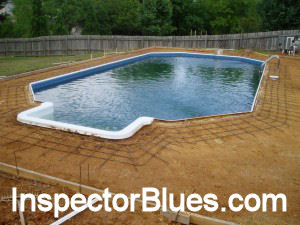August 11, 2008
Pool Equipotential Bonding Grid
I have had some complaints from pool contractors saying that some jurisdictions fail their grids if they are not supported being that structural steel should not be in contact with dirt. They also tell me that sometimes they fail becuase it is supported and the code technically says “…under the paved…”
Article 680.26C (2005 NEC) in refering to the equipotential bonding grid says “The equipotnetial common bonding grid shall extend under paved walking surfaces…”
Let me know what you think. Don’t email me, just comment below so everyone can see. I get comments through email, but the purpose of this online discussion is so other people can see you input.
Filed under Discussion Topic, Pools by .

Comments on Pool Equipotential Bonding Grid
2:02 pm
I believe you would eventually lose continuity of the pad if you place it on the ground. The intent of the code is to have an equipotential zone around the pool. When someone gets out of the pool , they would have the same electrical charge as the pad. Placing the pad on the ground, not encased in concrete, would invite corrosion, which we all know is enemy #1 to steel and electrical connections.
6:08 pm
I don’t care if it is on the ground or supported. I’m just happy if it is properly constructed, tightly connected, and covers as much of the pool circumference as possible.
5:59 am
How can you call it properly constructed when it is on the ground. There is a good chance it won’t be tightl after the ties rust away from moisture exposure.
2:34 pm
I agree with Jeff. If the steel is on the ground, it will rust. It needs to be
encased in the concrete.
2:46 pm
I recently put in a swimming pool, and the pool contractor installed rebar around the perimeter of the pool and under the 2′ of coping. I installed pavers that meet the coping and extend about 6′ from the edge of the coping. There is no decking around the perimeter of the pool. We installed sod. The walking extending from the coping is 3′ wide.
The electrical inspector did not approve the final inspection for the reason of “equipotential bonding grid was not inspected under walkway”. My electrician and pool contractor are debating what this means. The pool contractor says that I need to pull up 1′ of the pavers and put down sod in that 1′ section, and the electrician says we need to pull up 1′ of pavers and install 1′ of rebar around the entire of perimeter of the pool.
I’m completely confused and hope that someone can help with what needs to be done.
3:42 pm
Sherry
I’m Joe the owner of this site.
This Code comes from the 2005 NEC (National Electrical Code) Published by the NFPA (National Fire Protection Association). It’s Publication NFPA 70.
The section of the code is 680.26(C). The part of Concern reads as flooows
“The equipotential common bonding grid shall extend under paved walking surfaces for 1 m (3 ft) horizontally beyond the inside walls of the pool…”
If this walkway of concern is more than 3 feet from the walls of the pool it does not need an equipotential bonding grid.
It’s difficult to visualize your pool from your description. I’m not sure what you mean by “coping”.
Base on what you have said, I would tend to agree with the electrician, but I would almost need to see a picture. You can send me a picture. I emailed you and you can reply with a pictur if you want.
1:18 pm
2008 NEC has updated information on equipotential bonding that extends out horizontally 3′ from the inside walls of the pool…and “shall include unpaved surfaces as well as poured concrete and other types of paving”
11:12 pm
@Joe: Joe, Im installing pavers around my pool. From step 1. I lay the rebar around the coping 3′ feet out in a grid shape , just ont ground. Step 2 hook ground copper lines to rebar. Step 3 sand. Step 4 . Pavers. Is this corrrect?
7:02 am
@tony: Tony that sounds correct. Some inspectors like the rebar supported on chairs. The electrical code never mentions it being supported. The new code requires the grid even if the surface is not paved. So in that case you could not support it.
If it’s being inspected, I would ask the inspector if he wants it supported or not. What state, city or county is this located?
11:12 am
@Doug Watt: What is the rebar the for?
12:14 pm
@David: It’s an electrical bonding grid. A pool in the ground can act like a battery. I was at an indoor pool at a hotel once where it would shock me when I would touch the ladder. People can get shocked getting out of a pool when one foot is on the water and the other on a paved surface.
2:06 pm
After installing spas in my projects for over twenty years, all of a sudden, some cities or counties are requiring these equipotential bonds around the spas in or out of the ground. I have received permits in the past without them. I would think the self contained units wouldn’t need this. We’re placing this one on pavers over limestone aggregates and sand screed layer. What gives? I have seen this around pools since I started designing them in the eighties but never a spa. I’ll have to add this cost to the project and need confirmation or justification for the home owner.